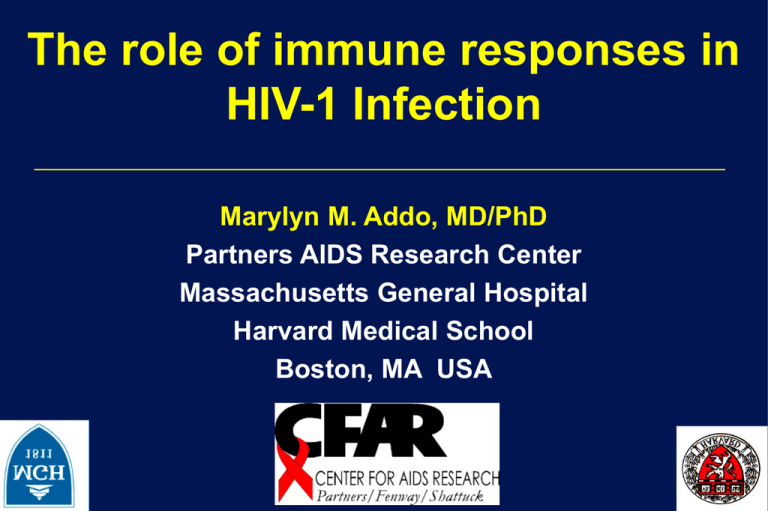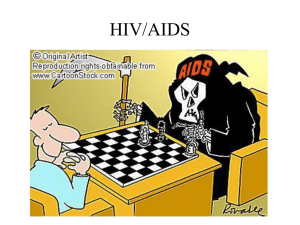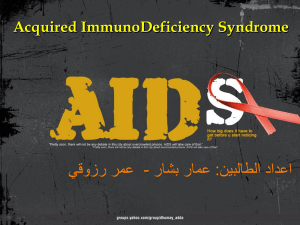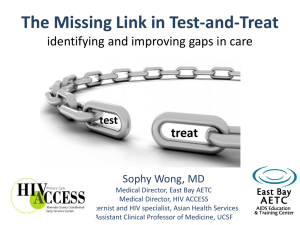
The role of immune responses in
HIV-1 Infection
Marylyn M. Addo, MD/PhD
Partners AIDS Research Center
Massachusetts General Hospital
Harvard Medical School
Boston, MA USA
HIV RNA copies/ml
CD4 per mm3
Natural History of HIV-1
symptoms
1000
106
CD4
800
105
HIV RNA
600
VZV
104
TB
400
Kaposi Sarcoma
200
PCP
CMV MAC Crypto Lymphoma
1
Time (years)
5
10
15
RNA particles/ml plasma
The level of HIV in the blood stream
predicts subsequent survival
Rapid Progression
Viral set point
Slow Progression
One year
What influences viral load in HIV
infection?
Viruses are not able to
reproduce on their own
New virus
assembly
2-3 Days
Viral set point is
determined
by number of viruses
produced by infected cells
Attenuated
virus
Potential factors
influencing the viral set
point
Host immune
response
Host genetic
factors
Attenuated
virus
Potential factors
influencing the viral set
point
Host immune
response
Host genetic
factors
HAART
Example: Sidney blood bank cohort
Attenuated
viruses
Virus had a “mistake” in the nef gene
New virus
assembly
2-3 Days
Attenuated
viruses
Host genetic
factors
Co-receptor polymorphisms
can prevent entry of virus into cells
32 base pair deletion
in CCR5
CD4
CCR5
Some molecules on the cell of an individual are associated
with improved viral control and slow disease progression
B27
B57
Migueles, PNAS 97:2709, 2000
Attenuated
viruses
Host genetic
factors
Host immune
responses
Humoral Immune System: Neutralizing Antibodies
New virus
assembly
B cell
Cellular immune
system:
Soluble
factors
Killer T cells
Cytotoxic T cell
New virus
assembly
Th
Soluble
factors
New virus
assembly
B cell
Th
Th
B cell
CTL
Th
The Generals
(T helper cells trained to target HIV)
Infantry
(CTL)
Generals
(T Helper cells)
Enemy
Infected cell
Why are the generals absent in
most infected persons?
Infantry
(CTL)
Generals
(T Helper cells)
Enemy
Infected cell
Relative magnitude
Virus-Specific T Helper Cells:
Essential for Maintenance of Effective CTL
Viremia
CTL
Viremia
CTL
Th cells absent
Th cells present
Is there any way to enhance the
immune response against HIV?
Infantry
(CTL)
Generals
(T helper cells)
Enemy
(Infected cells)
Infantry
(CTL)
Generals
(T Helper cells)
HAART
Enemy
(Infected cell)
Magnitude of Helper Cells
Effect of Early Treatment
on the Generals
(HIV-Specific T Helper Cells)
1000
100
10
1
0
20
40
60
Weeks on Treatment
80
What happens if you stop
treatment?
viral load (copies RNA/mL)
Early treatment of acute HIV infection
followed by treatment interruption
HAART
160000
120000
80000
40000
0
0
5
10
15
20
25
30
35
Weeks after first treatment interruption
40
Very early treatment with HAART
leads to enhanced natural control
of HIV
Where else do we find evidence for
immune control in AIDS virus infection ?
In monkey studies, removing killer cells led to
dramatic increases in viral load and restoring
Killer T cells in those same monkey studies led
to suppression of viral load
Individuals with high levels of Killer T cells
have been shown to have low viral loads
Two interesting groups of individuals
— HIV-1 long-term nonprogressors (LTNP)
— HIV-1 exposed, but uninfected individuals (HEPS)
LTNP
• Infected 21 years
• Normal T cells
• Undetectable viral load
• Never on anti-HIV meds
LTNP have strong and
broadly directed killer cell
responses and helper cell
responses
HEPS
Most well known:
— Nairobi sex worker cohort
(Rowland-Jones et al.)
— Found killer T cell
responses in these HEPS,
that may contribute to
protection from HIV
— Our group: collaboration
with Lusaka, Zambia (PI:
Susan Allen) studying killer
cells in discordant couples
and their partners
Poster session
Thursday 12-2 pm (Addo)
Vaccine development
Based on these pieces of data, it is felt that an
effective HIV-1 vaccine needs to elicit cellular
immune responses, in particular Killer T cell
responses +/- Helper T cell responses
Most recent and compelling data derive from
monkey studies demonstrating that Killer T
cell have an impact on vaccine efficacy in this
setting (Robbinson, Barouch/Letvin, Shiver)
Many vaccine approaches/trials currently in
study
Our current Research
Understanding of total the killer T cell and
helper cell response against HIV, not only
to single proteins like previous studies.
Analysis of the virus by sequencing
Bruce Walker morning Tuesday plenary
Addo A05 Tuesday 14-15:30
More research needed for other
virus types and other ethnicities
Durban, RSA
Immune responses in Clade
C-Infection
Mother to child transmission
and pediatric treatment and
treatment interruption
studies
NIH contract Epitope
mapping in Non-Caucasians
Lab
Nelson Mandela School of Medicine
University of Natal
Why is HIV not controlled by
the immune system like
other chronic viral
infections?
Mono
Chicken pox
Herpes simplex
Problems
VIRAL ESCAPE
VIRAL DIVERSITY
How HIV mutates to escape
Killer T-cells
Viral escape
Examples:
Goulder et al, Nature 2001
— Viral escape mutants can be transmitted
from mother to child
Barouch et al, Nature 2002
— Loss of viral control in a vaccinated animal
associated with viral escape in one epitope
Viral Diversity
Comparing Viruses:
How much does HIV evolve compared
to Flu?
Less Variation
More Variation
1997-1998
Canadian Flu
1996
Global Flu
Influenza variation
compared to HIV variation
1997-1998
Canadian Flu
1996
Global Flu
Influenza variation
compared to HIV variation
1990-1991
Amsterdam
1997
Dem Rep of Congo
The extreme variability of HIV
over time is a major impediment
to immune control, effective drug
therapy and vaccine development
Acknowledgements
Marcus Altfeld
Xu Yu
Almas Rathod
Cecily Fitzpatrick
Paul Lee
Philip Goulder
Christian Brander
Eric Rosenberg
Bruce Walker
Funding Sources:
German Research Council (DFG)
amfAR
Concerned Parents for AIDS Research (CPFA)
HLA-B27 is associated with slow progression to AIDS
106
105
Viral
Load
104
103
102
n = 10 HLA-B27+
The dominant CTL response in HLA-B27+ individuals:
HIV Gag p24 KK10 epitope
K
I
W
R
G
I
L
L
HLA B27 molecule
L
K
B27-KK10 escape is associated with elevated viral load
All Arg/Lys
at P2
106
105
Viral
Load
104
103
p=0.025
102
Controllers
Non-controllers
HIV Gag p24 KK10 epitope
K
K
M
I
W
R
G
I
L
L
HLA B27 molecule
L
K
B27-KK10 is recognized more frequently
in adult than in pediatric HIV infection
100%
CD8
1.55% pbmc
2.73% CD8s
IFN-g
80%
60%
40%
20%
0%
n=21 86%
p=0.02
n=6 33%
Adult Pediatric
B27-KK10 is not recognized in
children of B27-positive mothers
2000
IFN-g
SFC/
million
PBMC
1925
1600
1200
800
400
0
0
043-C
B27-ve mother
0
0
002-C 048-C 049-C
B27+ve mothers
B27-KK10 non-recognition associated with P2 anchor mutation
No P2 anchor
mutation
2000
IFN-g
SFC/
million
PBMC
1600
1200
800
P2 anchor
mutation
shared with
mother
400
0
043-C
B27-ve mother
0
0
0
002-C 048-C 049-C
B27+ve mothers





